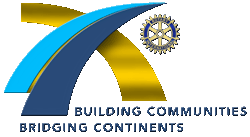‘Shoulder to Shoulder’ Plan -- A lifeline for member retention during tough times
For more than a decade, automotive services business owner ‘Harold Jamison’ had been an active Rotarian and local civic leader. Following his year as club president, Harold continued to accept leadership roles in Rotary, chaired the club’s endowment program, and volunteered for nearly every community service project. A multiple Paul Harris Fellow, a Rotary club could not ask for a more giving individual to represent the ideals of our organization than Harold.
Late last year, the downturn in our economy brought about what can only be termed the ‘perfect storm’ for this Rotarian and his family. His automotive business had just failed, and the buyer of his recently sold residence defaulted on a note payable. And, like most of us, Harold and his wife watched their retirement portfolio nearly evaporate in the closing months of 2008. Cash reserves that would have normally provided a ‘lifeboat’ for the crisis this family was experiencing were simply not available. Clearly, more than just emotions were sinking.
It was quickly becoming evident this Rotarian would not be able to meet his ongoing financial obligations to an organization to which he has been so committed for so many years. Rotary was about to lose a valuable long-time member who, under other circumstances, may have continued being active in Rotary for another decade or more. Truly a loss for all concerned.
Fortunately, Harold’s Rotary club in District 5160 had recently launched a unique retention strategy to address unforeseen instances such as this. The goal of the club’s ‘Shoulder-To-Shoulder’ program, now in its second year, is to reduce potential resignations of deserving Rotarians who have been a member for at least one year, are experiencing extreme financial hardship, yet are willing to remain active members through regular attendance and by participating in club service projects.
For Rotarians approved for eligibility in the S-2-S program, annual dues, luncheon billings and other financial obligations related to membership may be waived for a period of (up to) one year. To insure that the member is living up to his or her part of the agreement, an informal review is conducted every ninety days. If a need still exists, and provided the member has continued to maintain attendance and participate in ‘no-cost’ club activities, this fee exemption program can be ongoing -- for up to one year.
For confidentiality purposes, and to avoid any embarrassment to the member, only the club president, membership director and treasurer are brought into the process. The club’s board of directors, in approving the S-2-S program last year, gave broad discretion to a committee comprised of these two officers and its membership director, trusting that sound judgment would prevail in granting a member this exemption and then closely monitoring its progress.
The Board concurred that the anticipated loss of (dues and luncheon) revenues could be absorbed with a minimal impact on club finances. The rationale is that, by lending a helping hand at a critical time, temporarily removing the financial obstacles of being a Rotarian would enable an individual to remain active in a club service role and also benefit from the ongoing emotional support of the club’s fellowship. Most importantly, when economic recovery for the member does occur, it is very likely this Rotarian may feel even a stronger allegiance to the organization, recognizing we make ‘helping our own’ as high a priority as helping others in the community. Caring is a two-way street. When we care enough about our own members to take action, we are also taking a meaningful step towards membership retention.
It may be too early to gauge the long-term success of this fledgling program, however initial results are encouraging. During the 15 months since the S-2-S program was created in this club, four deserving Rotarians were deemed to be eligible by the committee. After being on the program for less than six months, two of those members are back on solid-footing and have resumed handling financial obligations on their own - - one relocated out of the area in order to secure employment, but hopes to become active in a Rotary club in his new locale.
As for Harold, he has recently found employment with a start-up venture that appears to have potential. He attends club luncheon meetings whenever possible and currently serves as president of his Rotary club’s Foundation and chairs their monthly board meeting. Harold is confident his situation is improving as each month goes by, grateful that his Rotary affiliation and fellow Rotarians provided this lifeline which enables him to continue the work of Rotary and yet focus on the challenges that still persist in his professional and personal life.
As Rotarians, we are frequently encouraged to apply the 4-Way Test to the things we think, say and do. When it comes to helping a fellow Rotarian maintain active membership during difficult times, this club’s innovative Shoulder to Shoulder program certainly meets all the criteria!
For additional information on the Shoulder to Shoulder program mentioned in this article, contact:
Rick Ernst, Membership Director
Rotary Club of Concord, CA USA
District 5160
email: rick_ernst@comcast.net

No comments:
Post a Comment